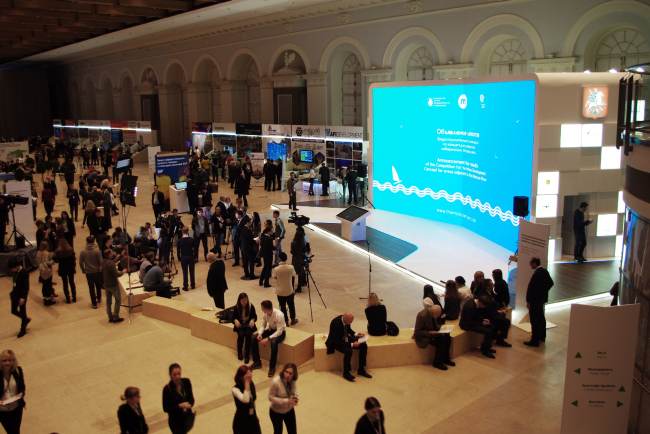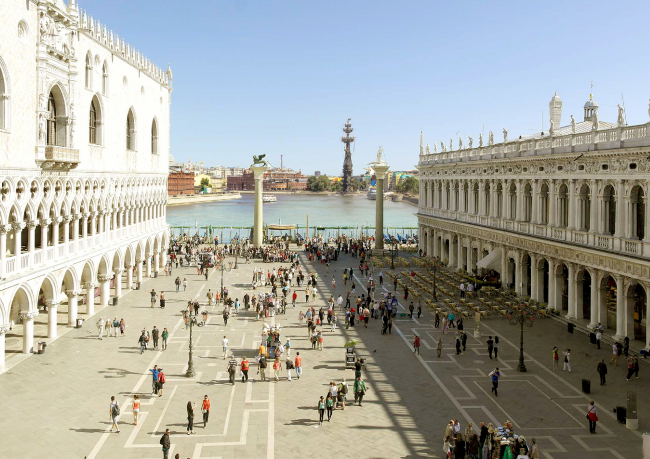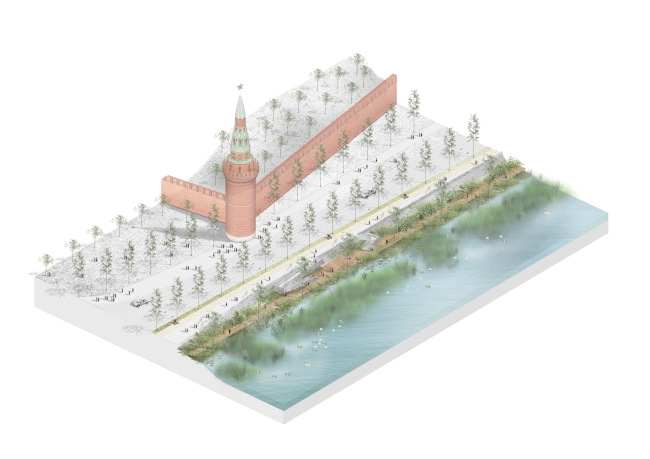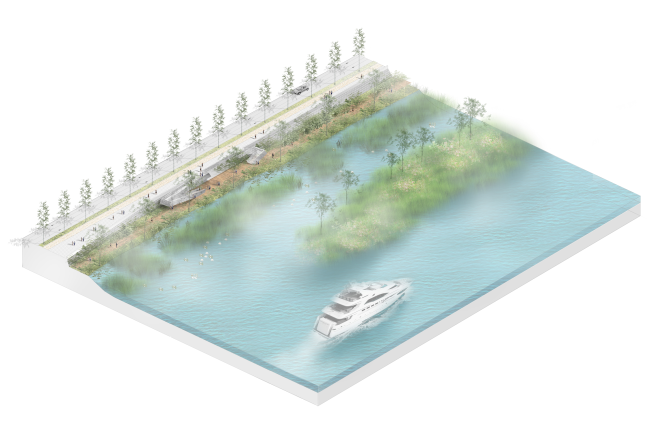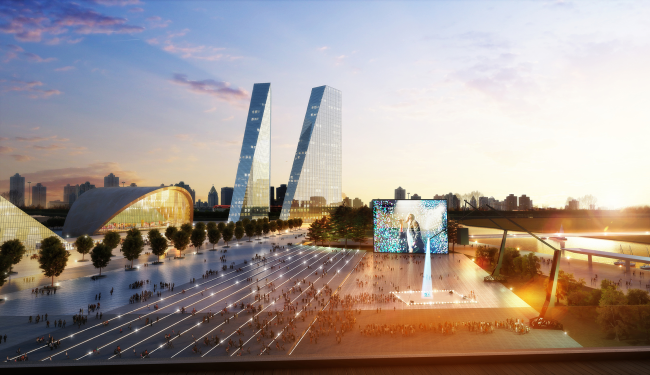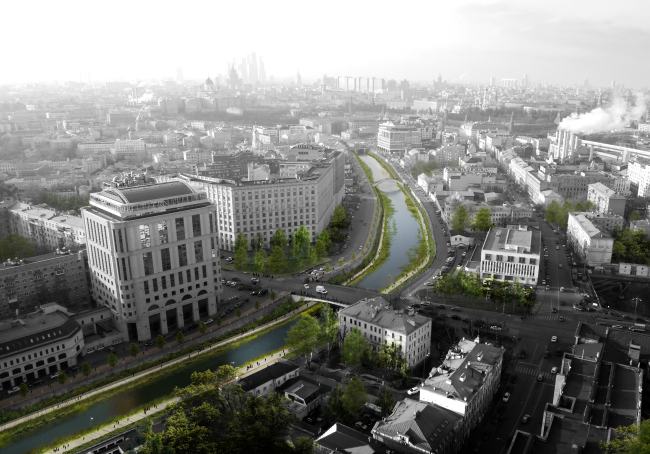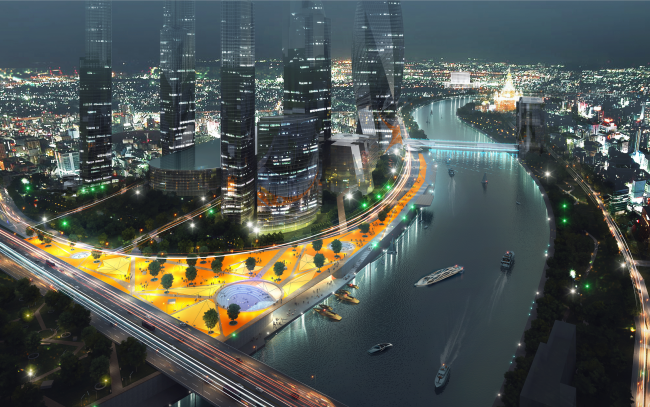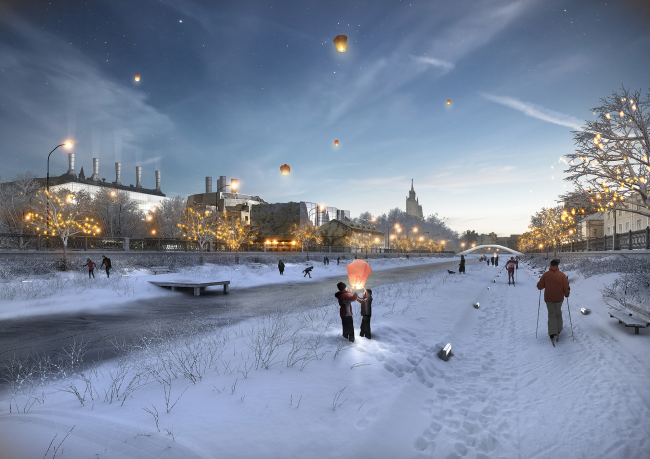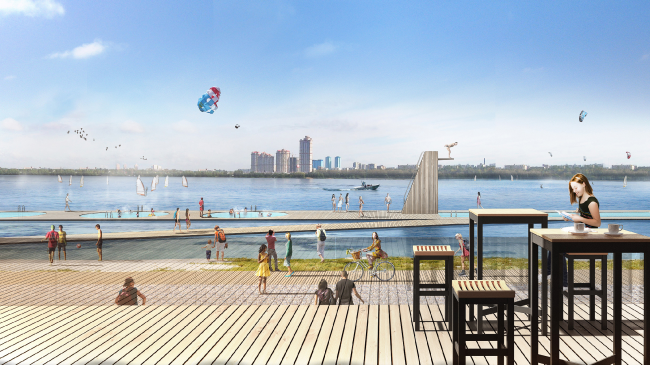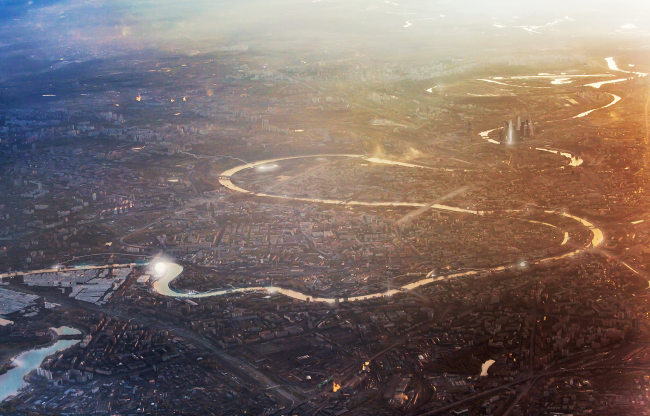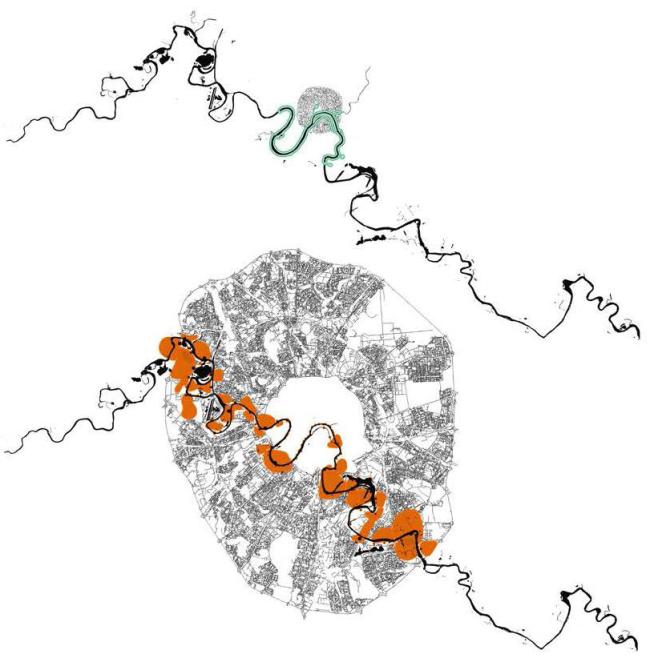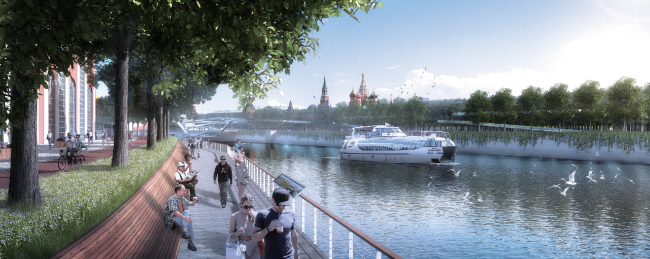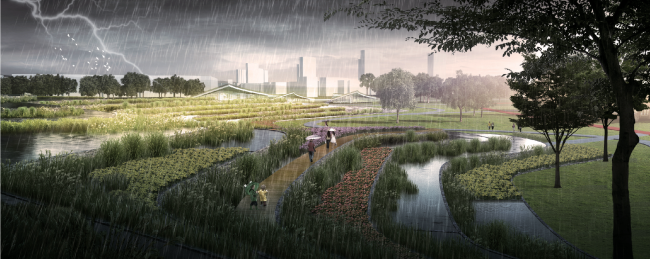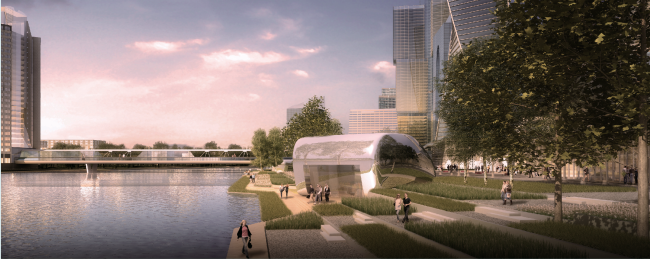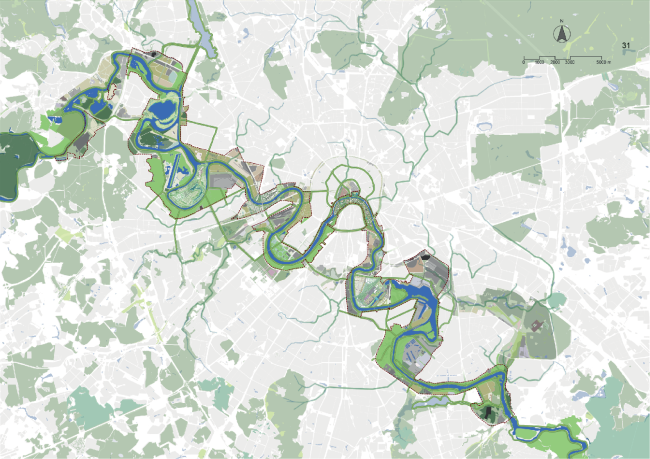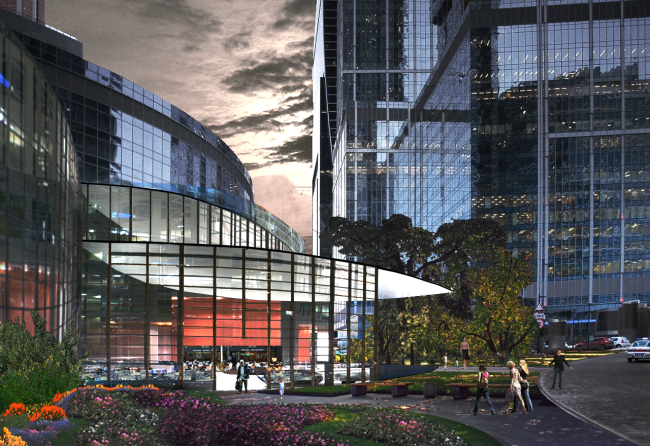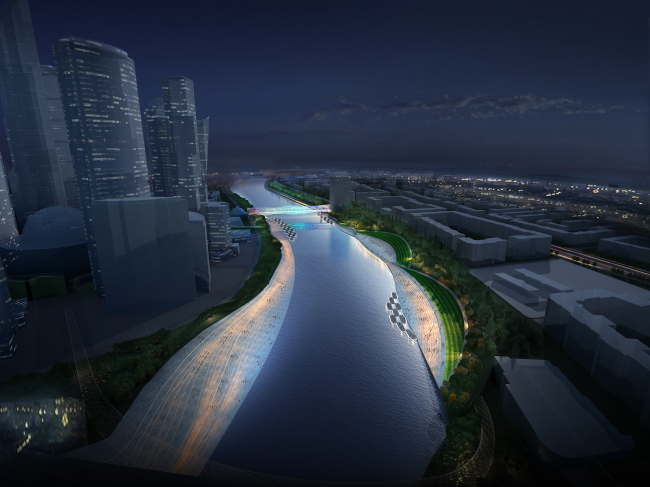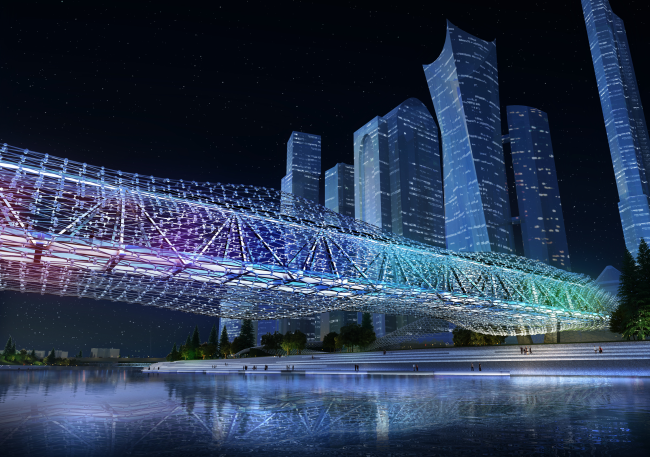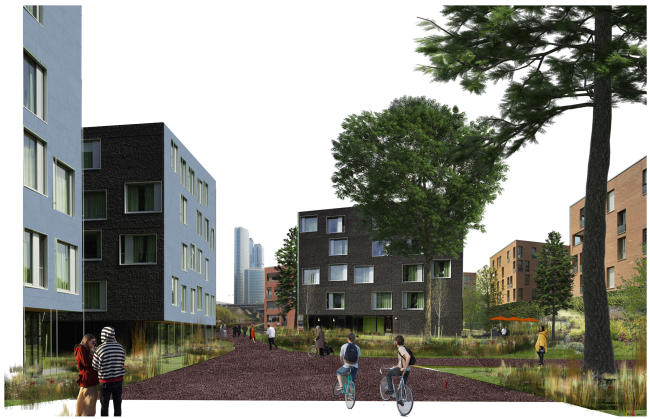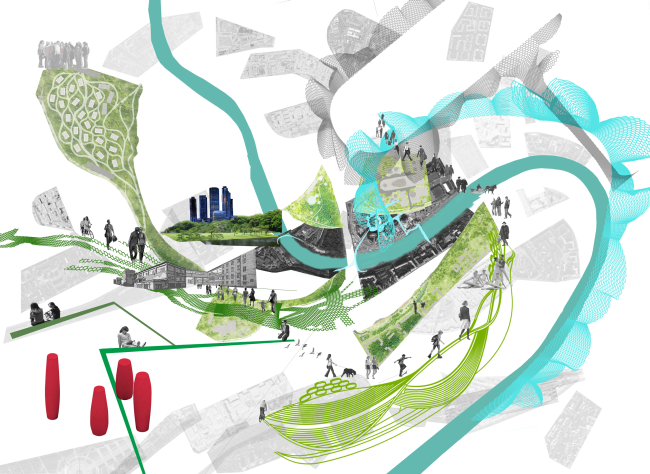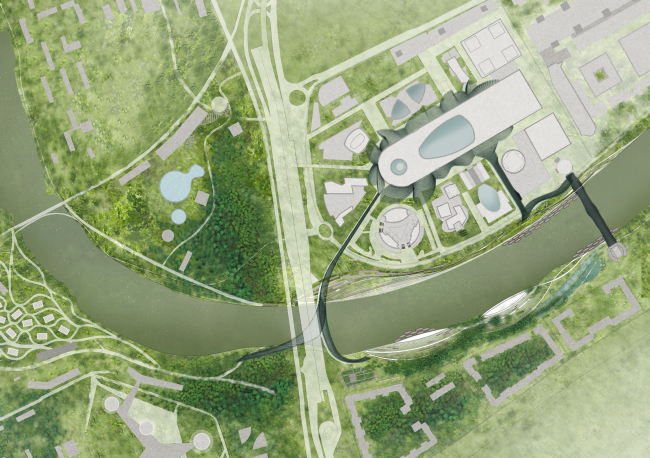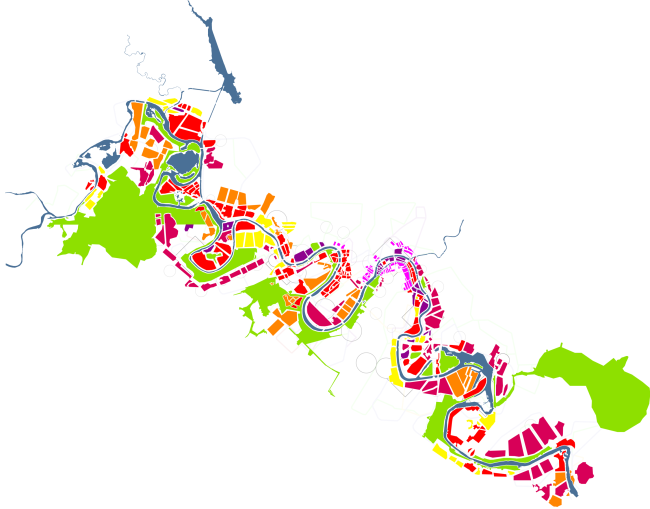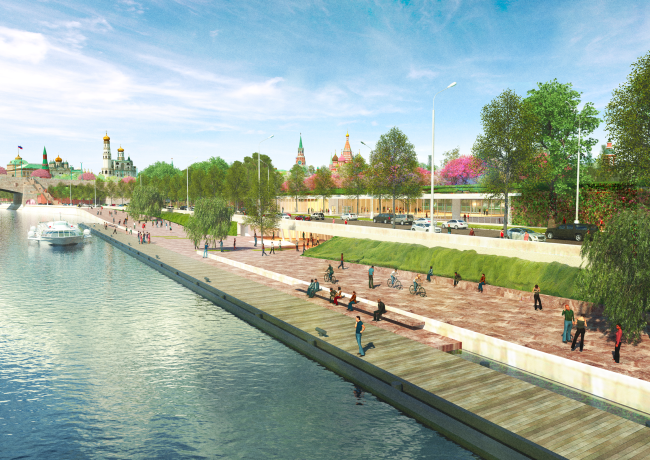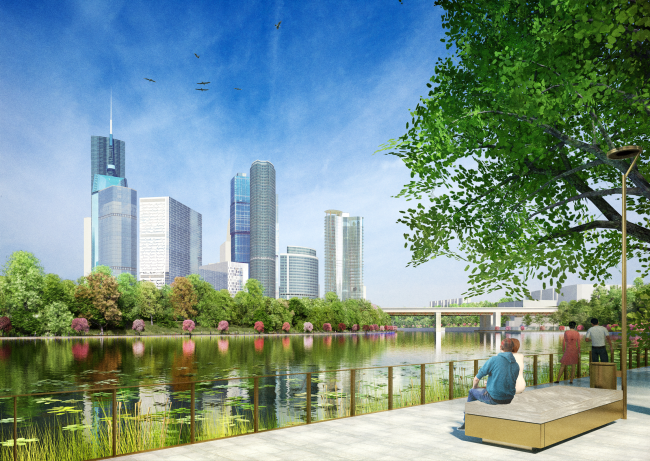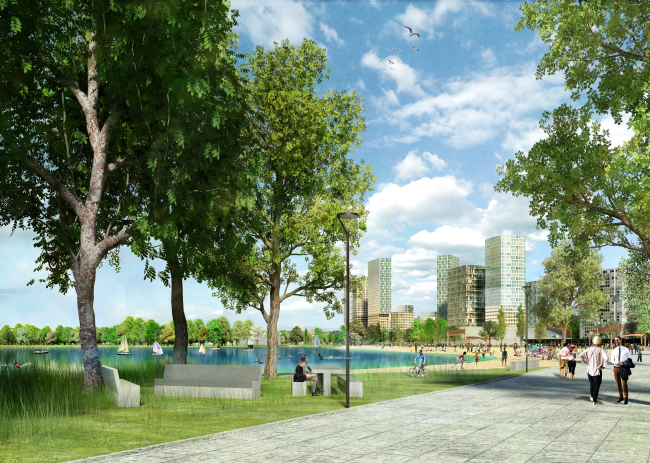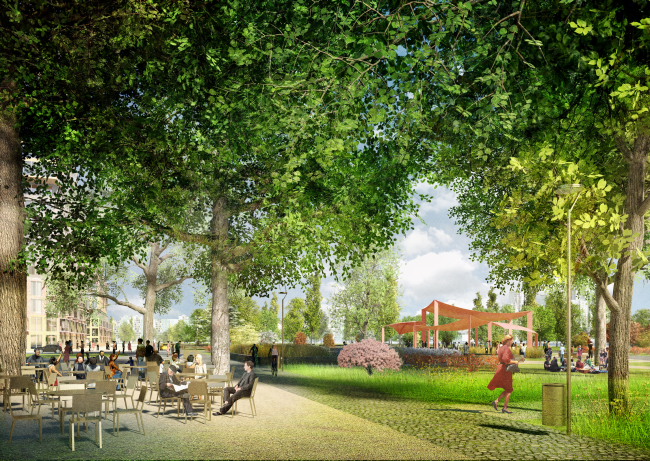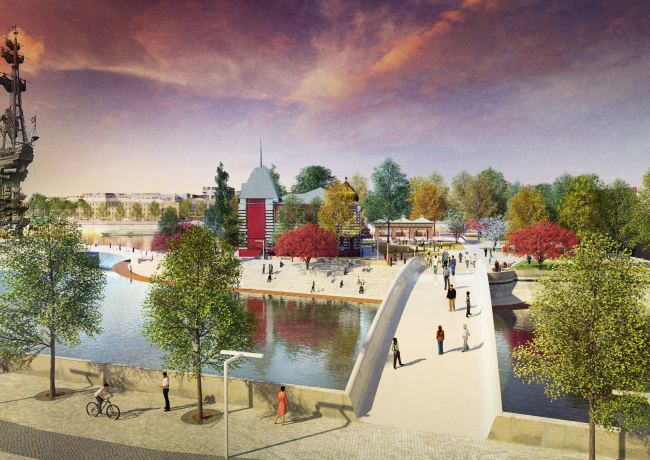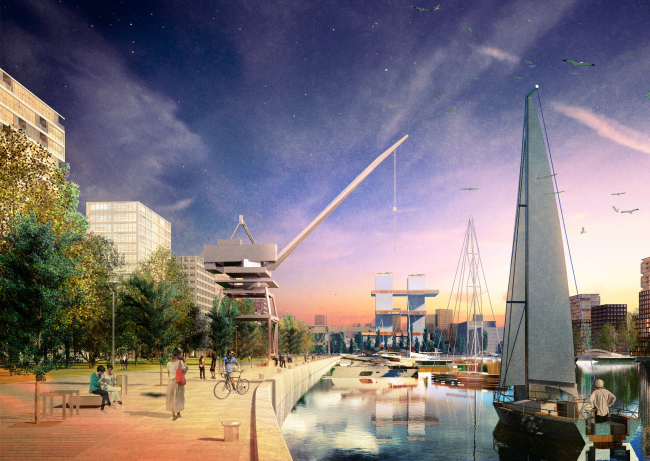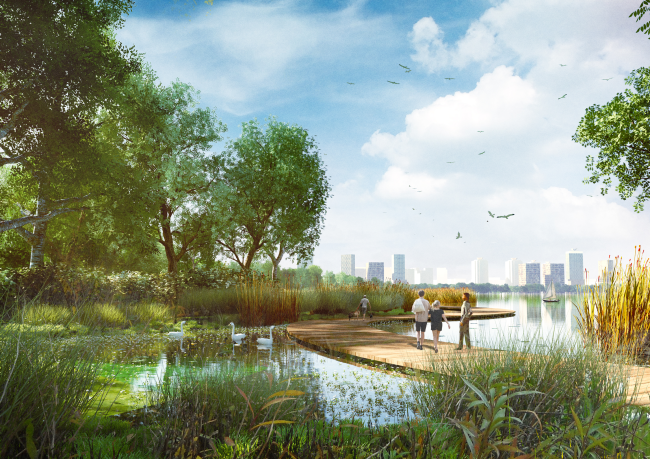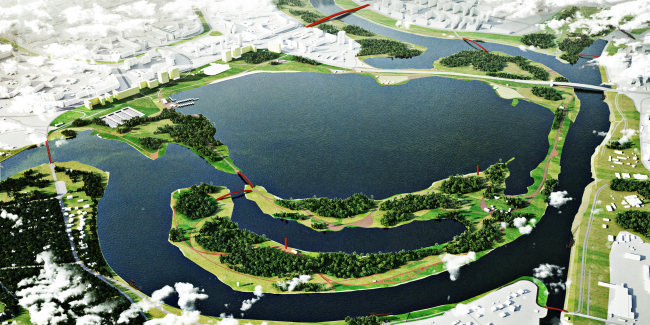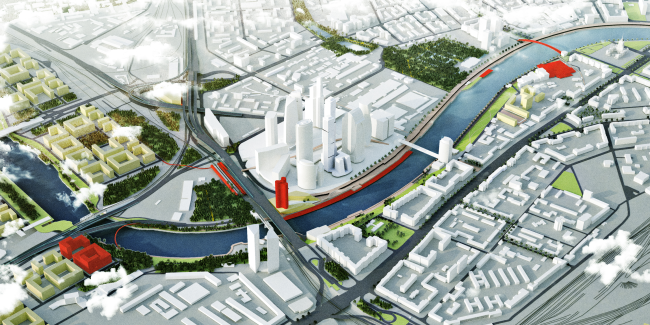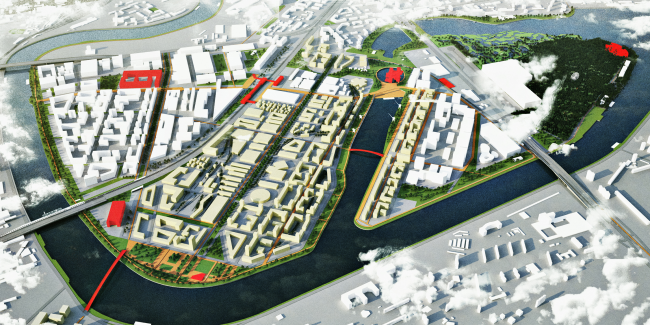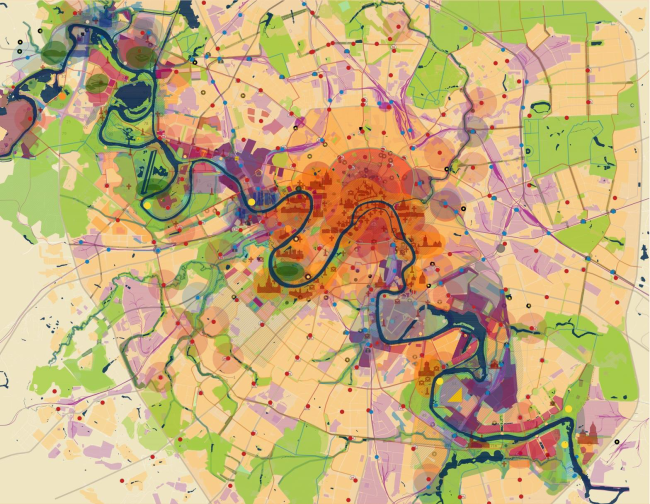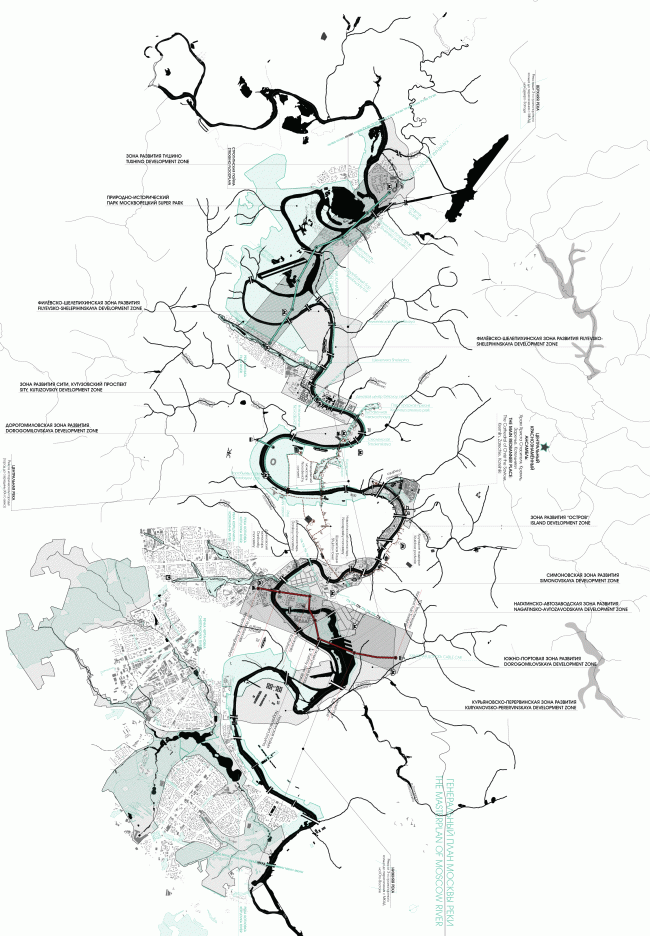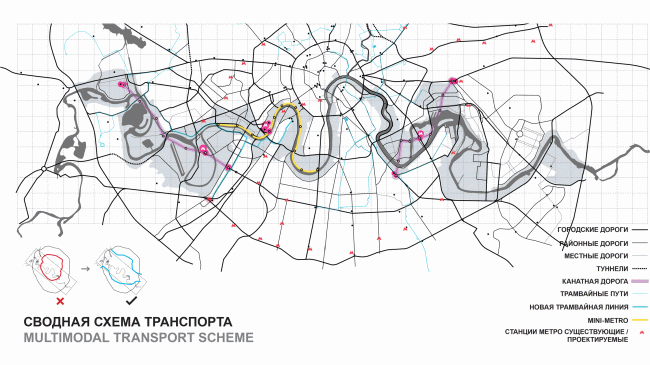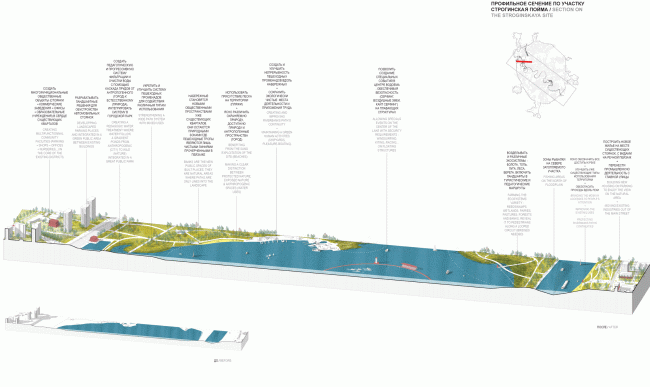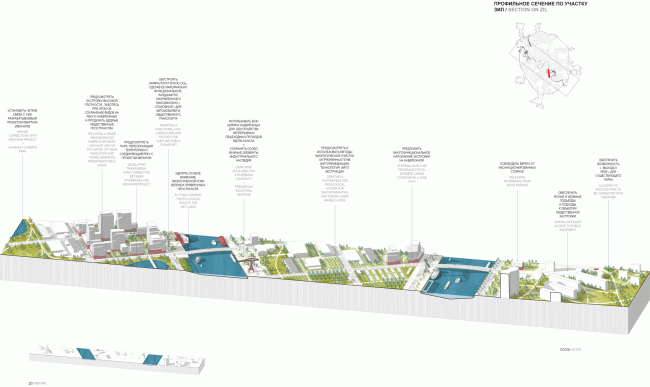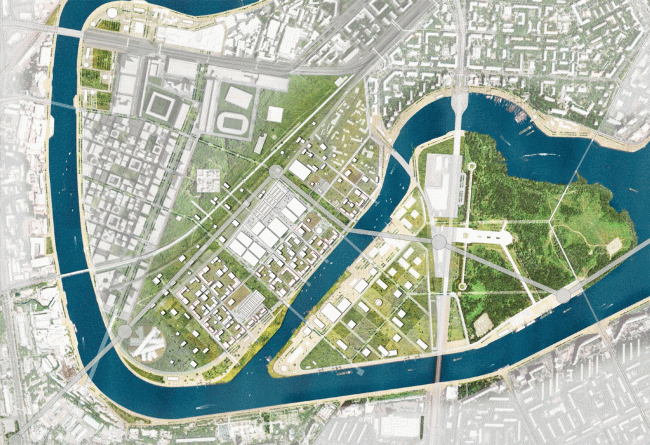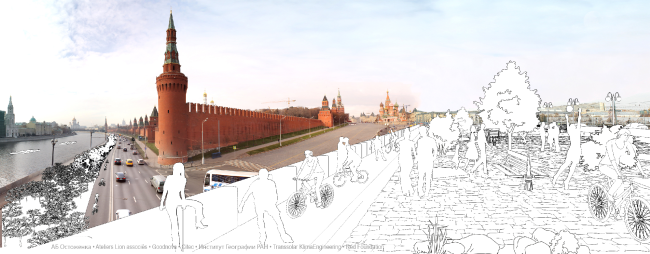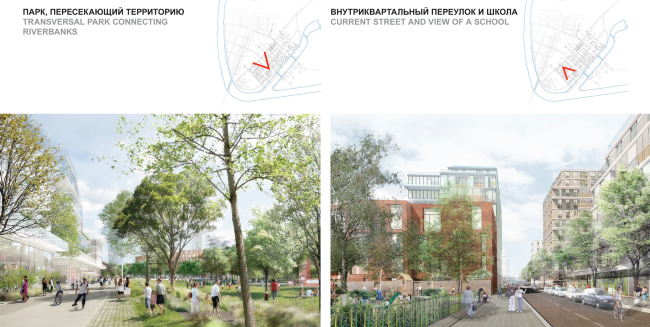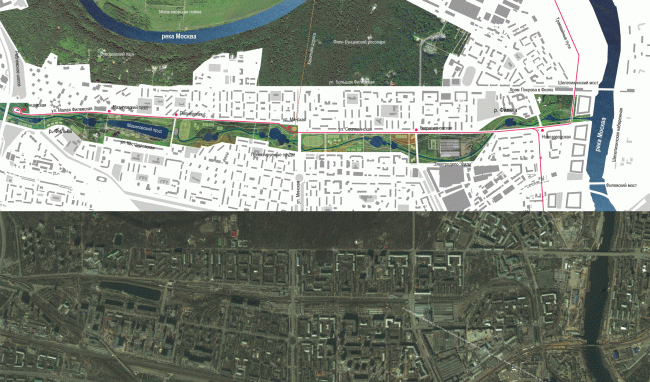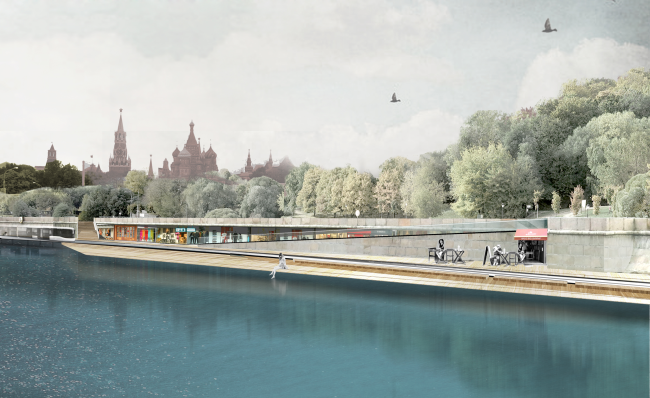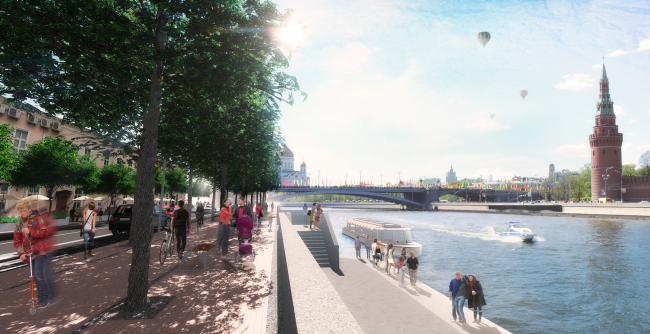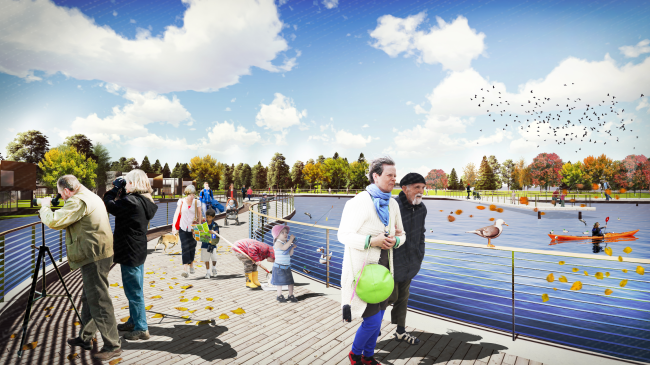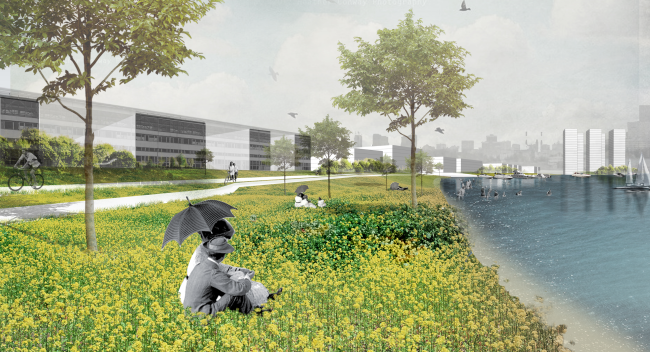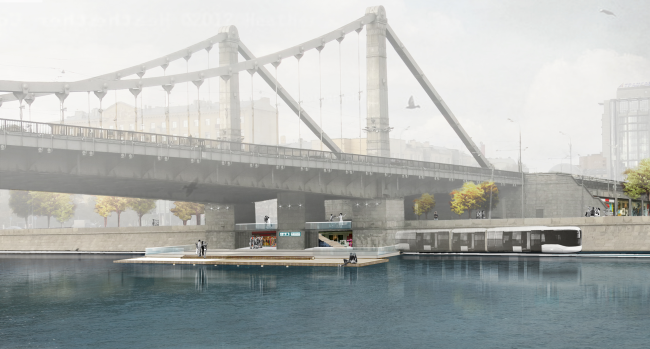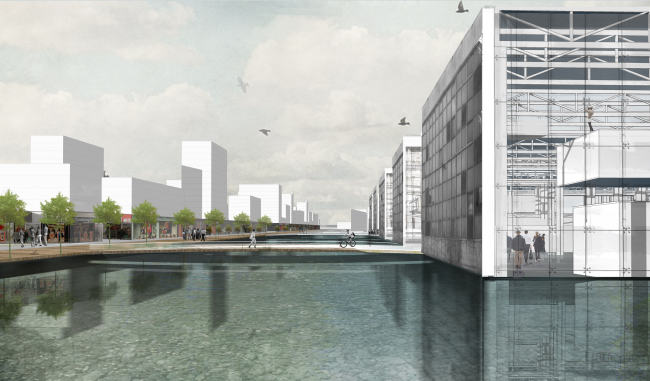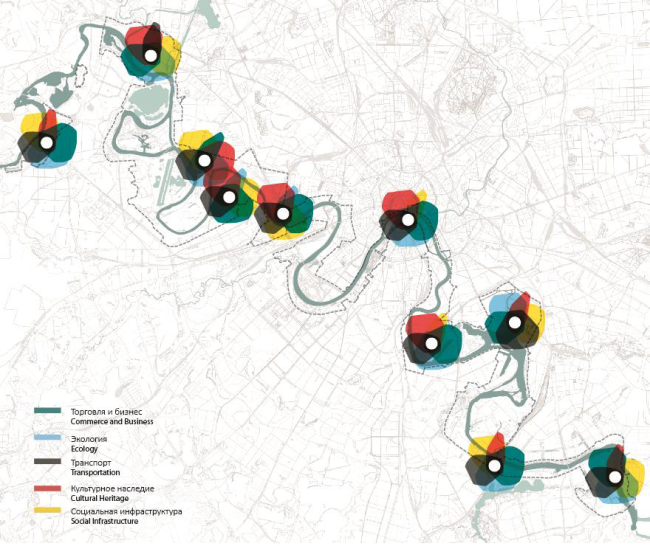|
Published on Archi.ru (https://archi.ru) |
|
| 12.12.2014 | |
|
Six Projects for the Riverfront Development |
|
|
Alla Pavlikova, |
|
|
In this issue, we are publishing all the concepts proposed by the participants of one of the most prominent contests of the year: one for the development of the riverfront of the Moskva River. [upd: the new pictures “Ostozhenka” bureau] Press conference in Manezh. Central Stand. Photo © Alla Pavlikova, Archi.ruAs we already reported, the international competition for the development of the town-building concept of the territories adjacent to the Moskva River was won by the consortium headed by "Project Meganom" Bureau. In accordance with the conditions of competition, the winner will be invited as a consultant for the further work on the project. At the IV Moscow Urban Forum, the results of the competition were personally announced by the Moscow mayor Sergey Sobyanin who gathered the representatives of all the six finalist teams before the central stand of Manezh exhibition center; the mayor said that the most interesting and the most vital proposals - and such, according to the mayor, were there in every proposed concept with no exception - would be used in the further wok on the implementation of the grand-scale plan. The announcement of the result was preceded by a long meeting of the judging panel that went on, according to one of its members Alfonso Vegara, for more than ten hours. Meanwhile, according to Marat Khusnullin, each of the judges noted in their personal voting the project prepared by the team of "Meganom" that thus got really far ahead of the other competitors. Khusnullin also promised that some of the ideas would be implemented in the nearest future. Sergey Kuznetsov Chief architect of Moscow about the competition and about the Moskva River "I want to say that this is the largest urban planning competition, since the project covers more than ten thousand hectares of the territory, of about 10% of the entire territory of old Moscow. For the participation, we invited the world's best town-building teams, because of which we obtained the colossal base of the ideas that are really valuable for the further development of the city. The Moskva River must become a new central street of this city - like the Neva in Saint Petersburg. It is very important here to think over not only general town-building concept but also the architectural facade of this street. Therefore, the next stage will be a whole series of contests for all the significant objects standing along the Moskva River". Alfonso Vegara The Founder and the President of Fundacion Metropoli, a member of the judging panel bout the decision of the judging panel:  Alfonso Vegara, Founder and President of Fundacion Metropoli, member of the judging panel / Moscow Urban Forum, 2014“Our session went on for more than ten hours, in the course of which we very thoroughly analyzed and discussed the final presentations, discovering in them an abundance of the ideas very vital for this city - both at the regional level, and at the level of its separate territories. The project of developing the waterfront of the Moskva River is enormous in its scale. At the same time, I was amazed at the very number of diverse proposals that the contestants did on the town-planning, economic, and ecological levels. The contestants are real heroes. They did an amazing job and in such a short time, too, considering the fact that Moscow is one of the world's largest cities. I think that this experience is very important for the development of Moscow. To me, it was interesting to look at all the six projects - each one of them had in it practical, vital, and implementable proposals; therefore the idea to use not just one winning project, but also the proposals from the other teams that will be invited at different stages of our work, makes perfect sense to me”. Andrew Gnezdilov The chief architect of Scientific-Research and Design Institute of the General Plan of Moscow about the winning project: 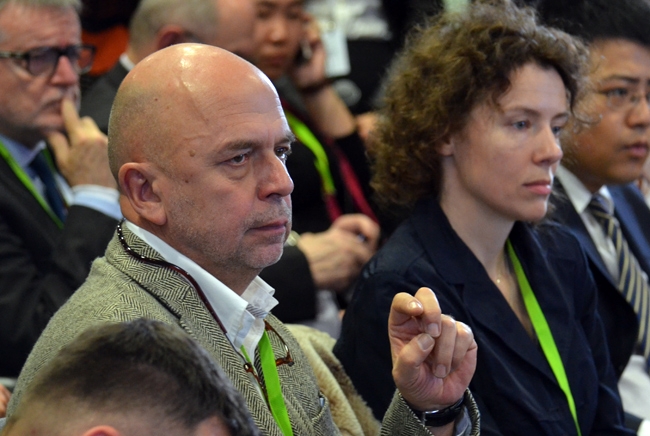 Andrew Gnezdilov (on the left, on the right - Marina Khrustaleva) / Moscow Urban Forum, 2014“The winning project was done by an amazingly strong team. I know Yury Grigoryan very well and I know that he possesses a great quality - the ability to formulate his thought accurately, always staying focused on what's really important. And he focused on the most important urban points, coming up with just right solutions. The concentration of efforts was of the highest type. Many contestants examined different aspects of the issue, attempting to solve these or those particular problems having to do with the water front. Meganom, however, was able to come up with an integrated and focused solution. And again, I cannot help but note how the participants were able, within such an unbelievably short term, (two months - editor's note) to achieve such amazing results. I must confess that I was only expecting some sort of general overall analysis, while in reality all of our contestants did great research work and finally submitted very profound final proposals". ***
The implementation of the concept will take place in three stages: the first stage will have to do with the implementation of the proposals on the improvement of the waterfront, and it is planned that it will be completed before 2017; the second covers more important town-building tasks - to be completed before 2025; all the work is due to be completed in 2035. We present to your attention the projects of winner of the contest, as well as the projects done by the other five consortiums that participated in the competition. Project Meganom Moscow. Ports of the Future Concept of the riverfront development of the Moskva River © MeganomThe consortium headed by “Meganom” concentrated its attention on the ports - the portals that unite aqueous, pedestrian, bicycle, and other routes, thus forming “acupuncture of intensification”. The authors also proposed the idea of "ecological islands" that will filter the surface drain: “water flows into the lagoon between the breakwaters and gets purified, simply by going around the island”, and they planted the banks of the "Vodootvodny Kanal" ("Drain Channel"), and even the Kremlin embankment, with aqueous plants, adding a lot of soft water plants to the granite embankments. The plants will also filter and purify the water. As for the district of Strogino, the authors turned it into a sports park consisting of six zones, in the center of each of which there appears a "green building", none of them being exactly alike. Instead of the territory of Moscow City, the architects considered Mnevniki, placing there "Parliamentary Gardens" - ten gardens and parks. In the northern part of the peninsula, the architects reserved a place for the "modern iconic" building of the parliament center. The entrances to the parks, both sport and parliamentary, are expected to be free of charge. At the same time, as far as the territory of the ZIL plant is concerned, the architects re-did, giving it a few improvements and fixes, an earlier project of their own; we will remind you at this point that "Meganom" was one of the winners of the contest of 2012 for the reconstruction of the peninsula , although back then the first place was won by Scientific-Research and Design Institute of the General Plan of Moscow , and later, already in 2014, the territory of ZIL was again declared to be the object of attention - at this time, for participants of the competition for the waterfront of the Moskva River. Besides the main river, “Meganom” also considers the Yauza and Setun rivers. Meganom took Venice's San Marco as the prototype of its concept. Concept of the riverfront development of the Moskva River © MeganomConcept of the riverfront development of the Moskva River © MeganomConcept of the riverfront development of the Moskva River © MeganomConcept of the riverfront development of the Moskva River © MeganomConcept of the riverfront development of the Moskva River © MeganomYuri Grigoryan The leader of “Project Meganom” about the river as the spine of the city: 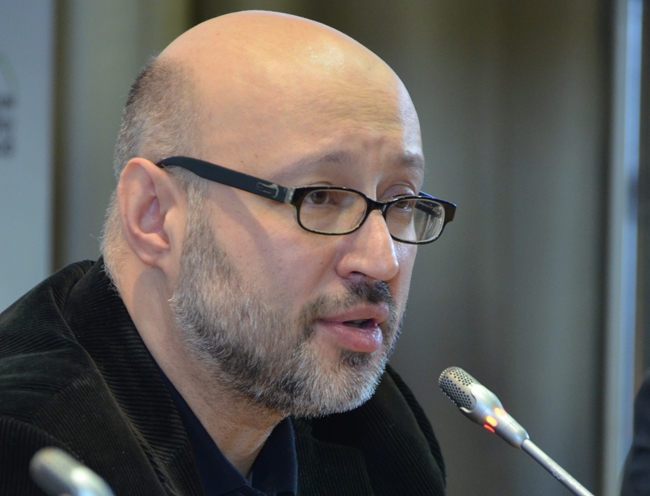 Yuri Grigoryan "Project Meganom", winner of the contest / Moscow Urban Forum, 2014“Our concept is called “Port of the Future”. We defined our primary goal as considering not only the Moskva River within the confines of the city but also give close attention to the whole system of the rivers with large and small inflows and channels as a single integrated eco-system. Together with the Moskva River, they must become clean, accessible and active. As far as city is concerned, we conditionally divided it into two parts: the center and the periphery. For the center, we propose softer, ecologically-oriented strategy: public territories along the river and the water-cleaning plants, transferred directly into the granite channels. For the outlying regions of Moscow, the Moskva River is mostly inaccessible to people, and that's why it will be a great idea to create access to the river together with the "ports" of the public areas. Thus, the Moskva River will become the linear center and the spine of thecity. It is important that this should lead to the uniform access to the water from the city's every district. These ports fall into two categories: large, "regional" ones, these being 11 in the making, and small "district" ones, these being 26. In the project, all the teams are required to condider in detail three main areas of Moscow: the Strogino Floodland, the complex "Moscow City", and the territory of the the ZIL automotive plant. We realized that, for Moscow, the main goal is the development of the district of Nizhnie Mnevniki, where the parliamentary center would be relocated. In our project, we called this point "Gardens of Parliament" because it is important to create a park with a parliamentary center, and not the other way around. The project "Planet ZIL" was developed by us within the framework of a different contest. Back then, it was there that we planned to place the parliamentary center. Now the situation has changed but ZIL will still be developing as a city within a city - it is really the size of a fully-fledged city with its own residentiaal buildings, shops, and workplaces. As far as Moscow City is concerned, for this territory we developed one of the large ports - a hybrid type with restaurants, shops, public territories and the so-coveted paring places in it. Together with the addition of the bright color solutions, this port could liven up the rather reserved complex of "Moscow City". One of the important proposals of our project was the idea to set up a date of a new holiday - Day of the River. We've got the Town Day but we haven't got the River Day This kind of townspeople holiday that includes public sailing of boats, would be able to remind the people that we do have a river in our city". Parliamentary gardens in Mnevniki. Concept of the riverfront development of the Moskva River © MeganomConcept of the riverfront development of the Moskva River © MeganomMoscow City. Concept of the riverfront development of the Moskva River © MeganomConcept of the riverfront development of the Moskva River © MeganomStrogino. Concept of the riverfront development of the Moskva River © MeganomConcept of the riverfront development of the Moskva River © MeganomConcept of the riverfront development of the Moskva River © Meganom***
Turenscape + Archpolis Turenscape International Limited / Russian partners Archpolis and DSK-1 Revival of the River Concept of the riverfront development of the Moskva River © Turenscape International LimitedTurenscape singled out five issues: ecology, transport, social balance, the need for cultural revival, and economic activity. They consider the river as the key element of the structure of the city, and propose the strategy of "anti-planning": the ecology gets an absolute priority over any kind of modernization; environmental considerations are to be considered first before introducing any changes. The new "human-oriented" riverfront transportation network provides for significant speed limits for cars, at the same time introducing ice-skating and skiing trails. The environmental system of Strogino Floodland is left completely intact. The Krasnopresnenskaya Embankment is transformed into a pedestrian zone, the automotive traffic being routed to the "Year of 1905" and Mantullinskaya streets. Along the river, the authors propose to create park terraces, an amphitheatre with the flooring and other zones of leisure. The territory of the ZIL plant gets coverted into a green zone or “Social Factory”. Besides the recreation areas, the architect also create the "Science and Technology" and "Fine Arts" institutes, as well as a tower with residential, commercial, hotel, recreational, and public segments. Concept of the riverfront development of the Moskva River © Turenscape International LimitedConcept of the riverfront development of the Moskva River © Turenscape International LimitedConcept of the riverfront development of the Moskva River © Turenscape International Limited*** Burgos&Garrido + Citymakers Burgos&Garrido / Russian partner - Citymakers Linear "flowing" center on the Moskva River: from archipelago to mosaic Concept of the riverfront development of the Moskva River © Burgos&Garrido ArquitectosWithout dividing the territory of the riverfront of the Moskva River into zones or areas, the architects propose to mix a few functional scenarios in one "layered" land plot, each with its landmaark building that would attraact the people from other areas of Moscow. The “Laminar” or "layered" system will make it possible to reorganize the territory gradually, and each zone will be immediately provided with all the necessary services. The authors propose the creation of new transport interchange hubs, a new unit of ground-based transportation, metro, and a network of parkings. The water transport is expected to develop at the expense of the construction of new quays and marinas that will also function as the recreational spaces. The natural scenery of the Strogino Floodland also gets pedestrian and bicycle trails, as well as some small-size service points. The restored buildings of the ZIL plant are saturated with the business and social functions and continue the industrial aesthetics of the place in their new facades and public territories. 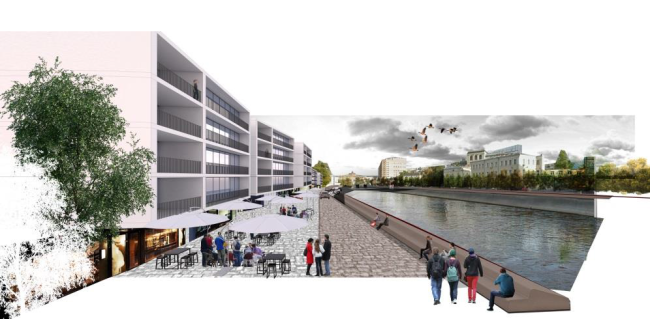 Concept of the riverfront development of the Moskva River © Burgos&Garrido Arquitectos Concept of the riverfront development of the Moskva River © Burgos&Garrido Arquitectos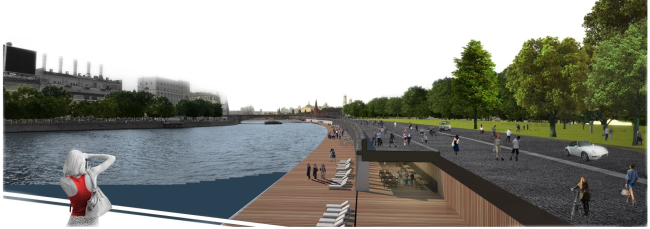 Concept of the riverfront development of the Moskva River © Burgos&Garrido ArquitectosConcept of the riverfront development of the Moskva River © Burgos&Garrido ArquitectosConcept of the riverfront development of the Moskva River © Burgos&Garrido ArquitectosConcept of the riverfront development of the Moskva River © Burgos&Garrido ArquitectosConcept of the riverfront development of the Moskva River © Burgos&Garrido ArquitectosConcept of the riverfront development of the Moskva River © Burgos&Garrido ArquitectosConcept of the riverfront development of the Moskva River © Burgos&Garrido ArquitectosConcept of the riverfront development of the Moskva River © Burgos&Garrido Arquitectos***
Maxwan + Atrium Maxwan architects + urbanists / "Atrium" Bureau Rediscovering the Moskva River Concept of the riverfront development of the Moskva River © Maxwan + AtriumMaxwan bases the ideology of the project on the following four cornerstones: developing the network of pedestrian and bicycle trails together with the public transportation; creating the landmarks that would reflect "the spirit of the place"; transformation of the problem territories; rivival of the natural waterfont, a few other specific areas of the Moskva River, and creating the green corridors. The authors propose to improve the water transportation, and to create interchange transport hubs next to the river, thus ensuring the connection between the different types of transport. The natural environment of the Strogino Floodland is kept intact together with the developement of the bicycle and pedestrian networks. New apartment houses are placed on the edges of the natural territory. In Moscow City, the architects landscape the embankment, create the landmark centers and territories, and develop pedestrian and bicycle network. At the ZIL plant, Maxwan proposes to create two "boulevard rings" and the "green wedges" starting from the Moskva River embankment and going further inside. The new residential and public buildings will be executed in the industrial style, inherent to ZIL. Concept of the riverfront development of the Moskva River © Maxwan + AtriumConcept of the riverfront development of the Moskva River © Maxwan + AtriumConcept of the riverfront development of the Moskva River © Maxwan + AtriumConcept of the riverfront development of the Moskva River © Maxwan + AtriumConcept of the riverfront development of the Moskva River © Maxwan + AtriumConcept of the riverfront development of the Moskva River © Maxwan + AtriumConcept of the riverfront development of the Moskva River © Maxwan + AtriumConcept of the riverfront development of the Moskva River © Maxwan + AtriumConcept of the riverfront development of the Moskva River © Maxwan + AtriumConcept of the riverfront development of the Moskva River © Maxwan + AtriumConcept of the riverfront development of the Moskva River © Maxwan + Atrium***
Ostozhenka Bureau The Moskva River in every part of the city Concept of the riverfront development of the Moskva River © Ostozhenka"Ostozhenka" treats the river as “the necklace of semantic sections” that connects the territories that are different meaning. The authors place along the river what they call “pedestrian capillaries”, treating the very river as a kind of longitudinal bridge that connects different places of the city. They propose to launch a few new types of barges, which will course along the river from Khoroshevo-Mnevniki to Nagatino: a beach barge, a restaurant barge, a skate park barge, and even a barge with a swimming pool. Realizing that the updating the pedestrian, bicycle and other positive forms of motion in the zone of the river requires a change of the entire structure of Moscow transport system as a whole, “Ostozhenka” proposes a number of measures: implementation of a "chord-line" system, building of the relief roads of Volgograd and Kutuzovskiy avenues, development of the transport permeability of industrial parks and other closed territories, development of the passenger transport, construction of ropeways and even a new mini-subway. The Shchukinsky Peninsula in the Strogino Floodland remains natural: the swamps, the willow coppices, the tallgrass meadows, picnics, bathing, eco-tours, moorages, and boats. The left bank of the Moscow City, on the other hand, becomes a highly industrialized area. Two new bridges are proposed; one leading to the Presnenskaya Embankment, the other to the 1st Kransogvardeisky Passage. On the high right bank of the river, i.e., on the side of the existing Kutuzovsky Avenue, the concept provides for a well-organized pedestrian embankment with the terraces and the spectacular view of Moscow City and the urbanized left shore. ZIL is developed on the basis of the old planning axes developed when it was still actually a plant; in the center, there is the neutral park zone. As the top priority, the authors consider the purification of the water in the creek and turning it into a "haven" - altough they say that they do realize that the dream of returning the Moskva River into its former riverbed is unrealistic because of the Zamoskvoretskaya metro line and the transport infrastructure connected with it. Furthermore, concept “Ostozhenka” provides for expanding the specifications beyond the subject of the Moskva River: the architects focus their attention on 140 plus inflows of the Moskva River, and propose a few versions of development of at least three of them, taking, as an example, the Filka River that now flows in the pipe under the subway line; this river will be opened back again and a park will be organized nearby. “Ultimately, the city will get a hundred rivers instead of just one" - the architects say. Concept of the riverfront development of the Moskva River © OstozhenkaConcept of the riverfront development of the Moskva River © OstozhenkaConcept of the riverfront development of the Moskva River © OstozhenkaProfile section along the Strogino Flood land. Concept of the riverfront development of the Moskva River © OstozhenkaProfile section along the ZIL Plant. Concept of the riverfront development of the Moskva River © OstozhenkaZIL Plant. Concept of the riverfront development of the Moskva River © OstozhenkaDevelopment of the territory of the ZIL Plant. Concept of the riverfront development of the Moskva River © OstozhenkaThe esplanade of the Moskvoretsky Bridge as the continuation of the Red Square. Concept of the riverfront development of the Moskva River © OstozhenkaConcept of the riverfront development of the Moskva River © OstozhenkaProposal of developing the Filka River. Concept of the riverfront development of the Moskva River © OstozhenkaProposal of developing the Gorodnya River: the southern analogue of the Moskvoretsk Park. Concept of the riverfront development of the Moskva River © Ostozhenka***
SWA + Rozhdestvenka SWA Group / the Russian partner “Rozhdestvenka” Bureau A case of poly-centric development, based on the resources of the river. Concept of the riverfront development of the Moskva River © SWA GroupSWA consider to be of the utmost importance the packing of the road network and the creation of the network of the high-speed transport, whose stops must become the place of attraction for the local residents and help to unite the local people. The architects propose to use the space under the bridges and the flyovers, organizing there public zones for conducting the leisure activities. The Strogino Floodland will get a lot of sports and entertainment venues (the project even provides for a new theater). The authors propose to cover the Filevskaya subway line and to create above it a “green avenue”, which will help to prolong the united pedestrian network of the embankments of the Moskva River. The project also provides for the reconstruction of the Filevskaya subway line: the authors propose to cover this line (now it is of the open-air type - translator's note) and to create above it “green avenue”, which prolongs the pedestrian network of the embankments of the Moscow River. The territory of the Moscow City will get a construction of a large amount of residential stock; the lower floors will be given to the commercial functions. A lot of attention is paid to the ZIL plant. The authors propose to route the water to this territory territory, at the same time creating islands with the residential and public sections - the water becomes the basic town-forming factor. The warehouses become multifunctional buildings that perform both office and residential functions. The high-rise warehouse will be converted into a theater and it will become not only the high-rise centerpiece but also a meaningful landmark of this land. Concept of the riverfront development of the Moskva River © SWA GroupConcept of the riverfront development of the Moskva River © SWA GroupConcept of the riverfront development of the Moskva River © SWA GroupConcept of the riverfront development of the Moskva River © SWA GroupConcept of the riverfront development of the Moskva River © SWA GroupConcept of the riverfront development of the Moskva River © SWA GroupConcept of the riverfront development of the Moskva River © SWA GroupConcept of the riverfront development of the Moskva River © SWA GroupConcept of the riverfront development of the Moskva River © SWA GroupConcept of the riverfront development of the Moskva River © SWA Group***
|
|
